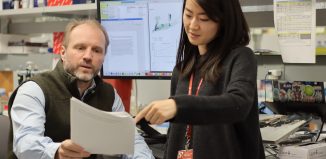BNL’s Pleier takes next steps after Higgs-boson
While the United States was celebrating Independence Day two years ago, a group of people were cheering the discovery of something they had spent almost half a century seeking. Physicists around the world were convinced the so-called Higgs boson particle existed, but no one had found clear-cut evidence of it.
At a well-attended press conference, scientists hailed the discovery, while recognizing the start of a new set of experiments and questions.
As a part of the ATLAS team, Marc-Andre Pleier knew what the group was set to announce. He was very excited “to see the signal confirmed by an independent measurement.” Two years later, Pleier, a physicist at Brookhaven National Laboratory and a part of a group of more than 3,000 scientists from around the world, are tackling the next set of questions.
The discovery “points to the Standard Model [of particle physics] being correct, but to know this we need to understand this new particle and its properties a lot better than we do now.”
According to the Standard Model of particle physics, the Big Bang beginning to the universe should have created equal parts matter and antimatter. If it did, the two opposite energies would have annihilated each other into light. An imbalance, however, resulted in a small fraction of matter surviving, forming the visible universe. The origin of this imbalance, however, is unknown, Pleier said.
“We know the Standard Models is incomplete,” he said, because there are observations of dark matter, dark energy and the antimatter/matter asymmetry in the universe that can’t be explained by this model. “We can test this” next chapter.
The process Pleier studies allows him to test whether the particle is doing its job as expected. In addition to analyzing data, Pleier also has “major responsibility in upgrading the detector,” said Hong Ma, a group leader in the Physics Department at BNL who recruited Pleier to join BNL in 2009.
Scientists at the Hadron Collider in Switzerland and at BNL and elsewhere are studying interactions that are incredibly rare among particles.
Pleier is searching for interactions of vector bosons, which have spin values of one and are extremely large in the world of bosons. He is looking for cases where two W bosons interact with each other.
“Only one event out of a hundred trillion events will be of interest to me,” said Pleier. Comparing those numbers to the world of biology, Pleier likened that to finding a single cell in an entire human body.
In 2012, the Hadron Collider produced 34 such interactions. The collider produces about 40 million pictures per second. To find the ones that might hold promising information, scientists like Pleier need to use a computing grid. BNL is one of only 10 tier 1 centers for ATLAS and the only one in the United States. Thus far, scientists have been able to look at these collisions from energies at 8 trillion electron volts. They hope to measure similar data at 13 trillion electron volts next year.
Ma said the increased energy of the collider will “put the Standard Model to an unprecedented level of tests,” allowing scientists to “measure the properties of Higgs boson to a higher precision.”
Growing up in Germany, Pleier said he loved playing with Legos to see how things worked. He helped fix his own toys. When he was older, he worked to repair a motor bike his uncle had.
What he’s doing now, he said, is exploring the fundamental building blocks of matter and their interactions. He likened it to examining the “construction kit” for the universe. While he’s a physicist, Pleier explained that he’s a Christian. “Some people think it has to be in conflict, but, for me, it clearly is not,” he said. “Each discovery adds to my admiration for God’s creation.”
A resident of Middle Island, Pleier lives with his wife Heather, an English teacher who is staying home for now to take care of their three children.
Pleier and Ma emphasized that the work at the collider is a collaborative effort involving scientists from institutions around the world.
Michael Kobel, a professor at TU Dresden, head of the Institute for Particle Physics and Dean of Studies in the Department of Physics who has known Pleier for about nine years, likened the process of studying the high energy particles to exploring a cave, where scientists “get more light to look deeper” into areas that were in the dark before. Researchers, he said, are just entering this cave of knowledge, with “a lot of corners yet to be explored.”






